BESTIARY (12B)
By:
September 4, 2021

One in a series of posts — curated by Matthew Battles — the ultimate goal of which is a high-lowbrow bestiary. This particular installment is in three parts.
All installments: 1904–1933: Busy as a beaver | 1934–1963: Eager beaver | 1964–2003: Beaver patrol
As noted in the previous installment in this series, US capitalism underwent a metamorphosis after the 1929 Crash. During this period, Baudrillard recounts, “Consumption became a strategic element, the people were mobilized henceforth as consumers, their ‘needs’ became as essential as their labor power.”
It should come as no surprise, then, that from 1934–1963 we see a shift in how the beaver shows up in American culture. Although the beaver’s busyness is still depicted as an admirable trait, particularly for youth, during this period it’s the beaver’s supposedly eager attitude that we hear most about. It’s not enough merely to beaver away at our given tasks, anymore; we’re now encouraged also to submit to authority, to volunteer for extra work, and to express (to quote Hebrews 11:1) “confidence in what we hope for and assurance about what we do not see.”
Although Mickey Mouse became a symbol of the can-do, gung-ho American during the Twenties and Thirties, my impression is that the beaver was understood to be a better fit for this role than a mouse. However, mice — especially Mickey, who kept getting cuter — are cuter than beavers. In order to sell the beaver as an all-American type, the beaver had to get cuter, too. Which is exactly what happens during this era.
We’ll see the Busy Beaver meme go from “dominant” to “residual” — to use Raymond Williams’s terminology. Which doesn’t mean that the Busy Beaver will vanish entirely…
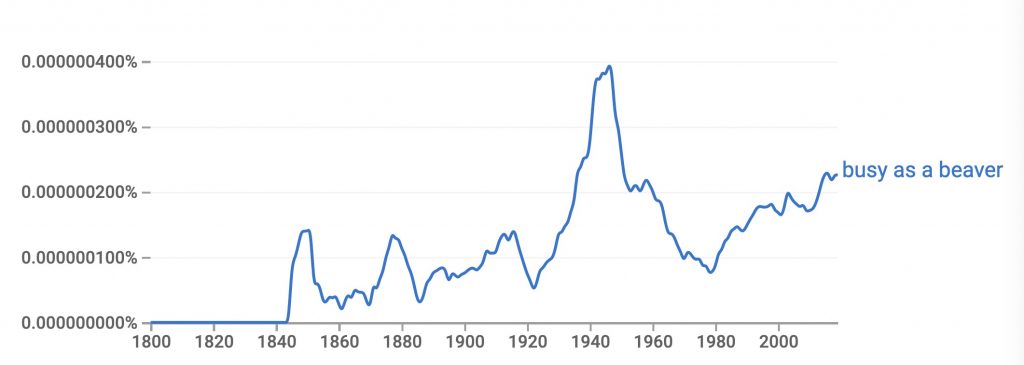
As noted earlier, the phrase “work like a beaver” spiked in popularity after the mid-19th century — and wouldn’t decline sharply until after WWII. The popularity of the mid-19th century coinage “busy as a beaver,” meanwhile, would skyrocket during the Thirties. And the phrase “eager beaver” — which, as I noted in the previous installment, dates back to the Teens — would be popularized near the end of the Thirties, supposedly by the US Army Air Force — whose instructors approvingly — but also, maybe, disparagingly? — called those cadets who most applied themselves to the important tasks in ground school and on the drill fields (i.e., not just in the air) “eager beavers.” So the Thirties — like the Oughts, Teens, and Twenties — ought to be a rich source of beaver-centric propaganda. Let’s take a look…
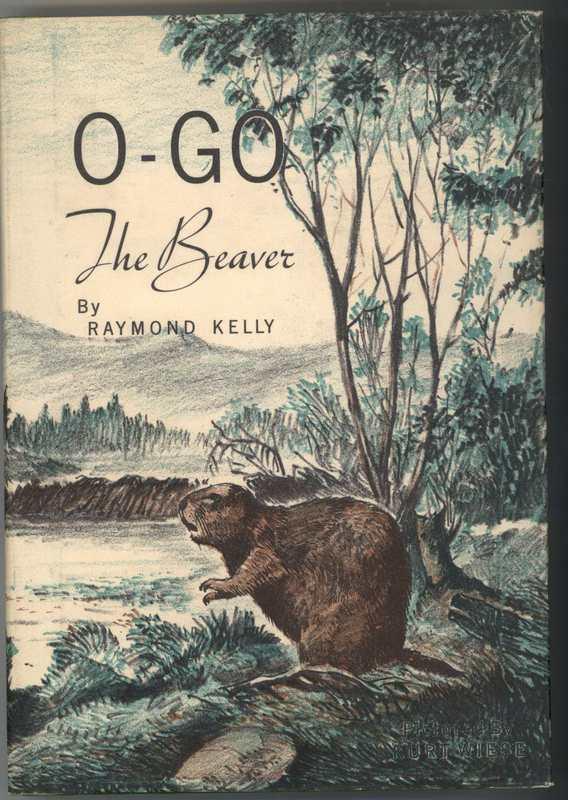
O-GO: O-Go the Beaver is a 1934 children’s book by Raymond Kelly, illustrated by Kurt Wiese. A curmudgeonly Goodreads reviewer has the following to report about the book:
[O-Go] is an intelligent, brave, inquisitive, and industrious beaver who exemplifies strong moral character traits throughout his life (in contrast to his lazy and delinquent brother). He learns to submit to authority, and to enjoy the benefits of his labor. He is also a gracious and caring beaver, harboring no malice toward any of his relatives. He would rather be wronged than react in rage when wrong is done to him.
One weakness of the book is that the policy of “If you don’t work, you don’t eat” is muddied at times. Although slothfulness is discouraged, O-GO’s lazy brother never ceases to be slothful and is never rebuked. The brother is allowed to eat from the communal food without assisting in it’s gathering.
Overall a great book that highlights many of the beaver’s character traits which should be taught and instilled into young boys.
This book represents a last gasp, I believe, of the neo-Victorian Busy Beaver meme…
In the 1934 Merrie Melodies short “Pop Goes Your Heart,” directed by Friz Freleng, we find a colony of beavers busily constructing lodges — although most of the other creatures we’ve seen, so far, are instead enjoying the spring weather. Surprisingly, this scene gives way to one in which we find beavers playing tennis — using spider webs as a net and their tails as rackets. When a hungry bear traps a hard-working crew of beavers in a tree, they playfully spank him, then drop a beehive on him with devastating effect. (Is this some kind of early warning to Germany — where Hitler became dictator in 1934 — not to mess with the US? See the 1942 Song of Victory short, below, for example.)
The emergence of the cheery, playful — and yes, eager — beaver parallels the evolution of Mickey Mouse around this time into a Boy Scout of sorts, typified by his “boundless energy, optimism, playfulness, independence, spunk, ingenuity, and a certain innocence” — anti-fascist traits, the Walt Disney Company wanted us to understand, which all good Americans should emulate. See my notes, below, about the emergence of a generic rodentoid toon.
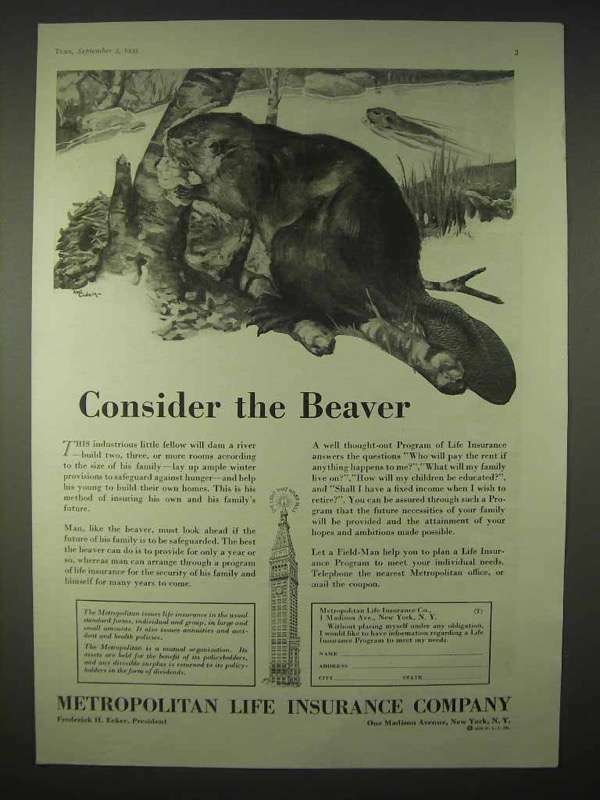
“This industrious little fellow will dam a river — built two, three, or more rooms according to the size of his family — lay up ample winter provisions to safeguard against hunger — and help his young to build their own homes. … Man, like the beaver, must look ahead if the future of his family is to be safeguarded.”
Another holdover of the Busy Beaver meme.
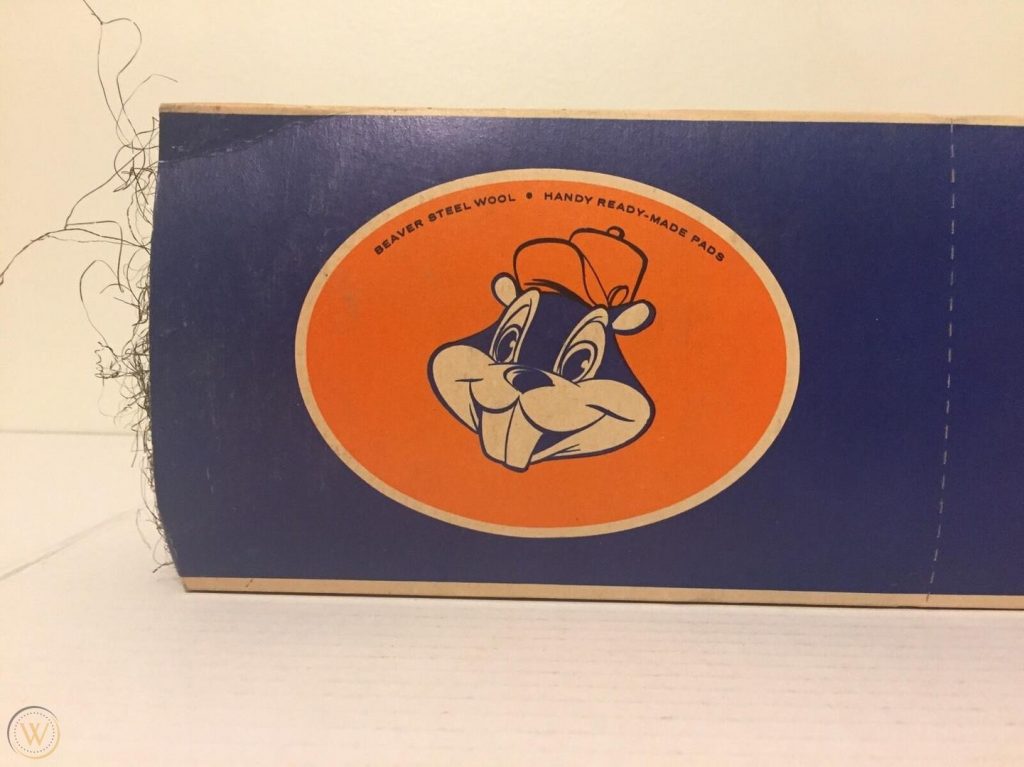
Beaver Steel Wool was registered in 1936 — to Beatrice Foods, a Chicago-based company. I’m not sure exactly when this cheery logo first appeared, though.
Note how cute the beavers in “Pop Goes Your Heart,” not to mention the steel-wool beaver, are. Cartoonish beavers of the Twenties had been far less cute — their teeth sharper, their expressions fiercer. Let’s keep an eye on this development.
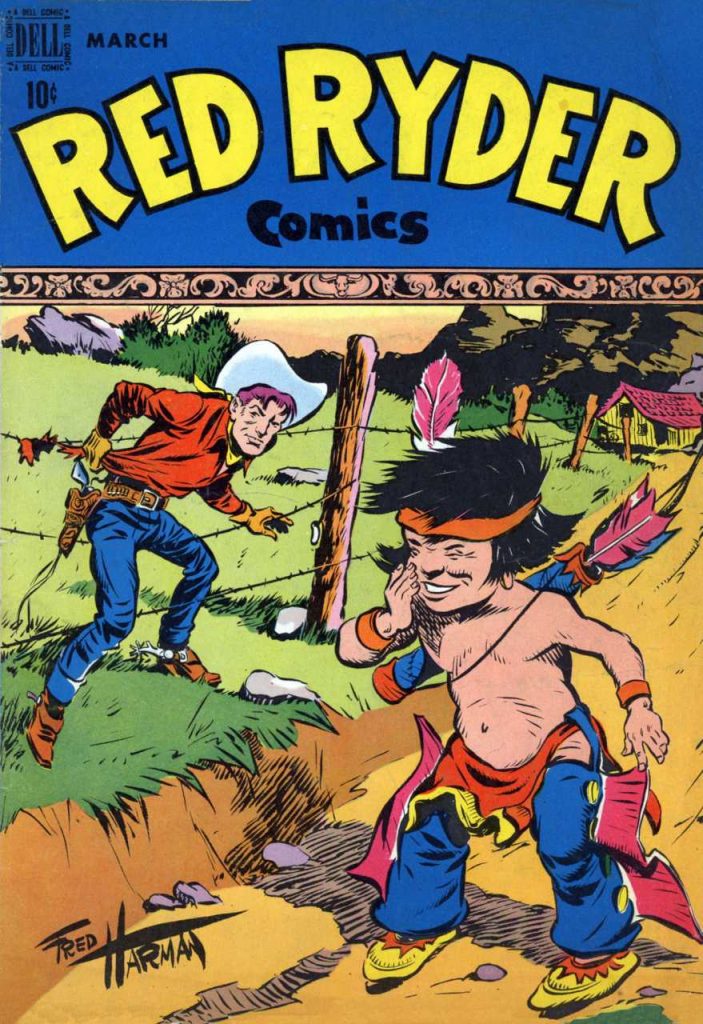
LITTLE BEAVER: Red Ryder, a Western comic strip created by Stephen Slesinger and Fred Harman in 1938, would remain popular through the 1960s — thanks in no small part to the cheery eagerness of the titular cowboy’s juvenile Native American sidekick, Little Beaver. Whose pidgin English (“You betchum, Red Ryder!”) is offensive, but who was a hit with kiddies. (PS: Bobby Blake, who’d grow up to be the actor Robert Blake, portrayed Little Beaver in movies in the mid-1940s.)
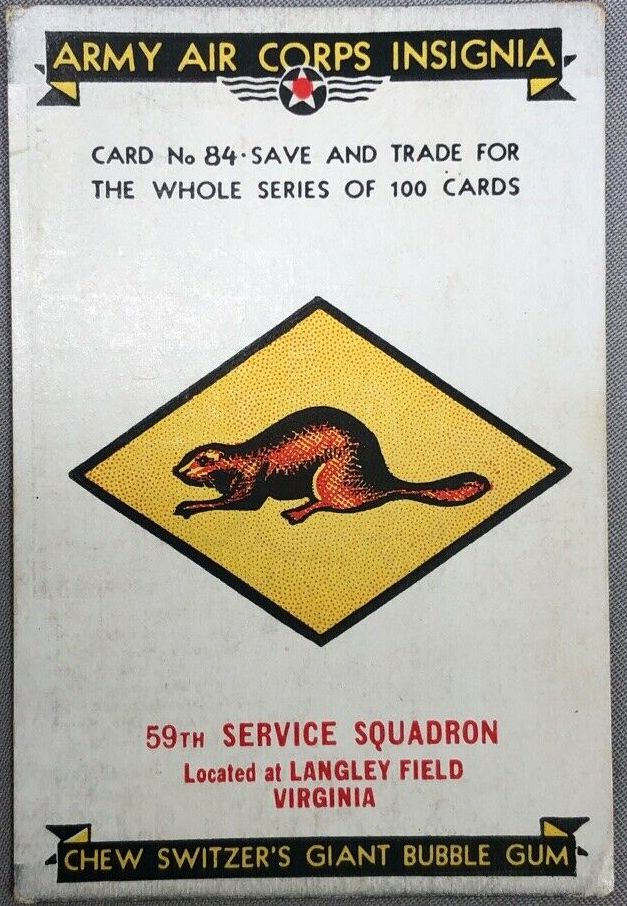
1938 Army Air Corp 59th Squadron Beaver Langley Field bubblegum card.
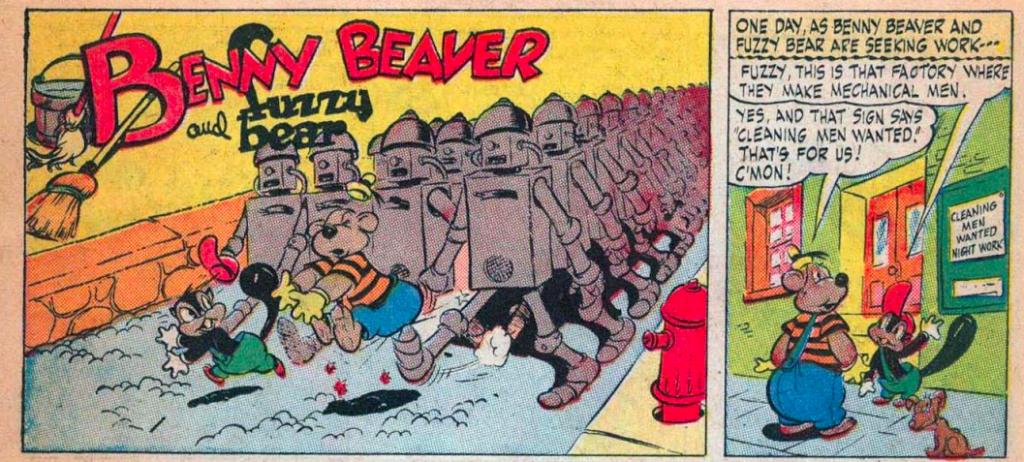
BENNY BEAVER: The character Benny Beaver began to appear in Fawcett comics — including Captain Marvel — beginning c. 1940. Benny is a hard worker saddled with a lazy companion (Fuzzy Bear) for comedic contrast. Which makes me wonder whether the moral lesson of the 1934 cartoon “Pop Goes Your Heart” (above) is that everyone really ought to work for a living… even bears.
JACK BEAVER: In Dumb Like a Fox, a 1941 Screen Gems cartoon, an irascible little fox hound is sent on the trail of a beaver, whom it believes to be a fox. (Directed by Lou Lilly, Allen Rose. With Mel Blanc.) This beaver — a cute one, named Jack — is miraculously good at building its dam. And good-tempered about the mix-up.
America entered WWII in December 1941. Which means that we’ll see the beaver pressed into service, once again, for the purposes of domestic propaganda.
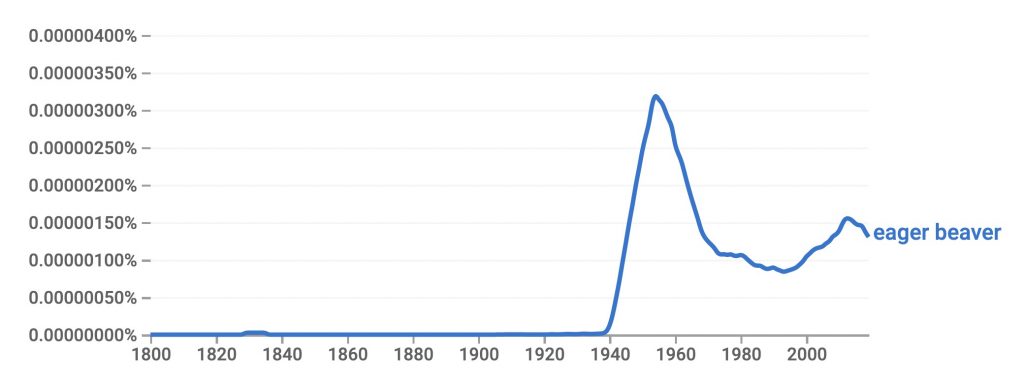
The phrase “eager beaver” begins its rapid ascent in popularity around this time — peaking during the Fifties. But see my note, in the previous series installment, from 1915.

The 1942 US propaganda poster shown here suggests that Americans should be as precise and industrious in their work as the beaver. (Note how anthropomorphized and cute this beaver is, vs. the WWI beaver.)
In a 1942 Screen Gems “Color Rhapsody” cartoon from 1942, “Song of Victory,” a vulture, gorilla and hyena who resemble Hitler, Mussolini, and Tojo bully woodland animals. Produced by Dave Fleischer. The perfectly coordinated efforts of cartoon animals — which in Twenties cartoons was depicted as charming and instructive — is here at first depicted as depressing, the forced coordination of the enslaved. But then, once the animals band together and fight back, their coordination — including that of the beavers, who fell a tree atop their foe — is inspiring.
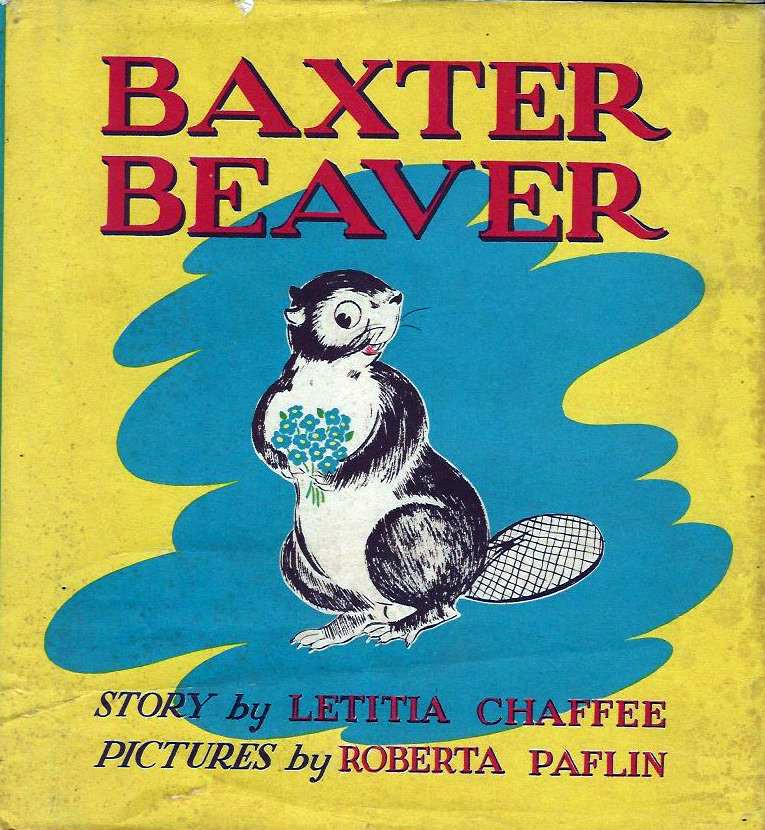
BAXTER BEAVER: Here’s a 1942 children’s book about Baxter Beaver. I haven’t read it… But note how, in order to make Baxter so adorable, he’s basically become a squirrel with a flat tail.
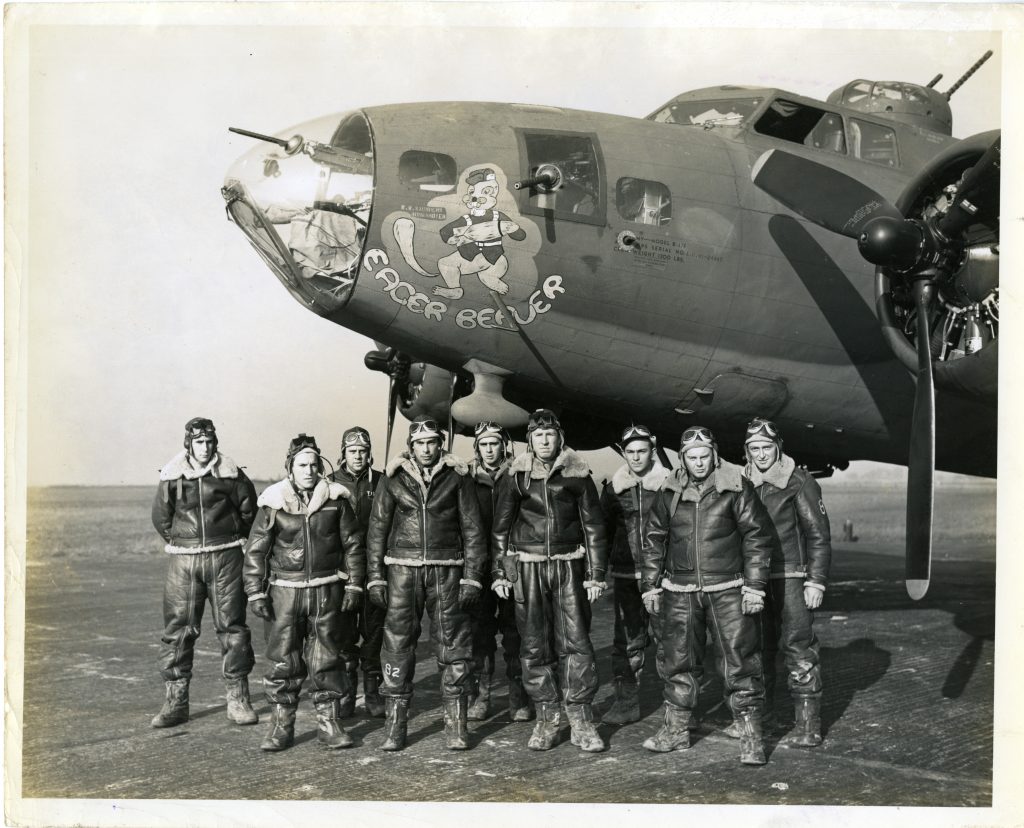
One final image from the Thirties. Here’s an American B-17 bomber crew posing in front of their aircraft, the Eager Beaver, in December 1942.
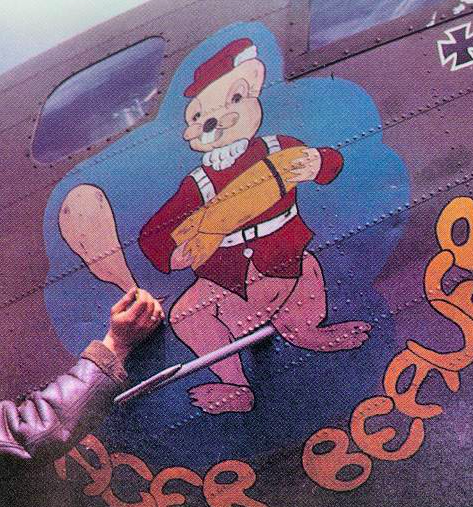
WWII ended in September 1945. In this section, we’ll whipsaw back and forth, from saccharine moralizing about hard work that seems lifted directly from the earliest part of the 20th century to… more subversive takes on the beaver.
One gets the sense that cartoons needed subversive rodent characters to take the place of Mickey Mouse, who by this point had “grown up a cow” (to quote David Bowie). Mice, squirrels, gophers, rabbits… and beavers, too, were pressed into service — to serve as antic foils to plodding dogs, cats, and humans.
This tendency in cartoons muddies the waters for our analysis. Is the subversive beaver we’ll find in the Forties actually… a beaver? Or is it instead a kind of cute, generic rodentoid invention that we ought to exclude from our study? Something to ponder, as you peruse the following notes.
Here’s another thing to think about. The first Boomers were born c. 1944 — as they became toddlers, were they bombarded with industrious-beaver propaganda? Or did the way that beavers were depicted for kiddies begin to … evolve? As we get to c. 1948, let’s see what we find.
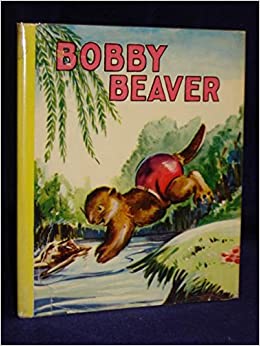
BOBBY BEAVER: This is a 1945 children’s book that I haven’t read.

BETSY BEAVER: Whoa, this is the only kids’ book I’ve come across that’s about a female beaver. Also published in 1945, it’s by Ruth Reed, with (charming, if amateurish-looking) illustrations by Norma Lyon.
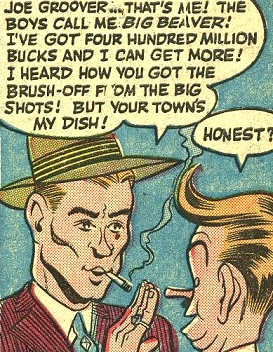
Here’s a c. 1945 Plastic Man villain.
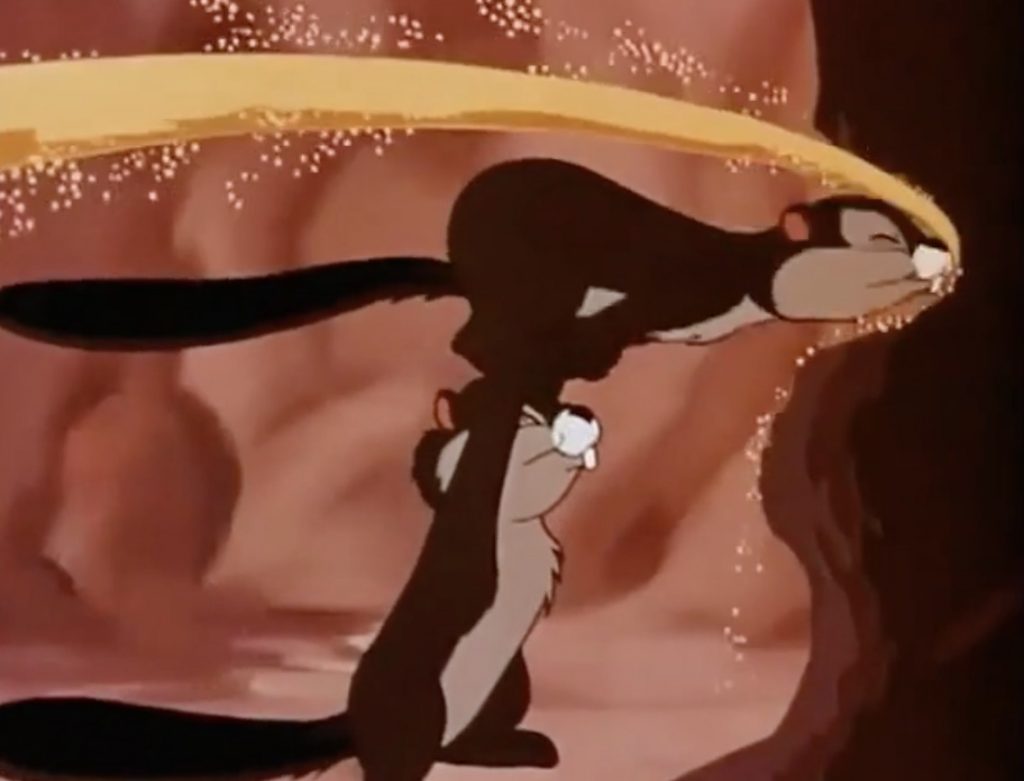
Here’s a moment from the 1945 Disney cartoon Old Sequoia, in which Donald Duck fails to protect a majestic tree from a pair of anarchic beavers. These beavers aren’t conservationists, nor are they humorless drones. In fact, they bear a striking resemblance not to beavers at all, but to the Disney characters Chip ‘n’ Dale.
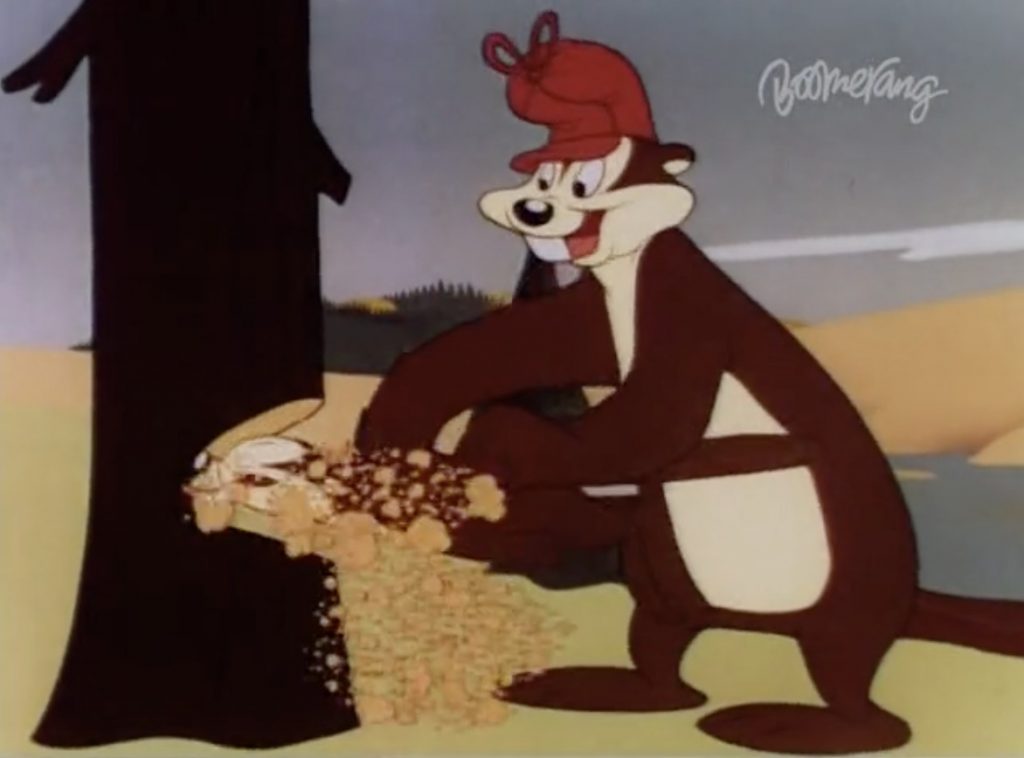
EAGER BEAVER: The Eager Beaver (1946) is a Merrie Melodies cartoon that begins by mocking the busy-as-a-beaver trope. The narration is knowingly saccharine and treacly — the way that kids were talked to once upon a time, we’re given to understand, but shouldn’t be any longer. The beavers are goofing off, not building dams or lodges; it’s like a scene from The Truman Show — we’re catching a glimpse of the strange truth.
When these beavers work in concert to “dam a river,” they end up swearing at it. As in a Twenties-era cartoon, the beavers use each other as tools… but here it’s played as absurd rather than ingenious.
Once the beavers do get down to working hard, the titular Eager Beaver — a sort of village idiot — shows up, and causes chaos. So this cartoon mocks not only the busy-as-a-beaver trope but the eager-beaver trope, too. He’s sent on a mission impossible, to get him out of the way… but somehow he does end up saving the day. Which ultimately suggests that it’s better to be an eager beaver than a busy beaver.
There’s a lesson in here, somewhere, about how an emergent trope unseats and dispossesses a dominant one.
JUNIOR BEAVER: By contrast… take a look at this 1947 Mighty Mouse cartoon, whose title — Lazy Beaver — is the opposite of the one we’ve just watched. Here we find a squirrel-like “busy little beaver family” hard at work, every action synchronized. It’s a throwback to Autumn (1930) or The Busy Beavers (1931), except that the beavers are cuter and the movie is in color.
This is a moralistic story. The titular little beaver, “Junior,” is a skiver, who finds a way out of working — and gets himself lost in the woods. When a wolf captures him, in order to make a beaver-fur coat out of him, Mighty Mouse swoops to the rescue. “Junior is now an eager beaver,” the narrator reports approvingly.
Like most cartoons from the Terrytoons studios, this one is larded down with moralist sentimentality.
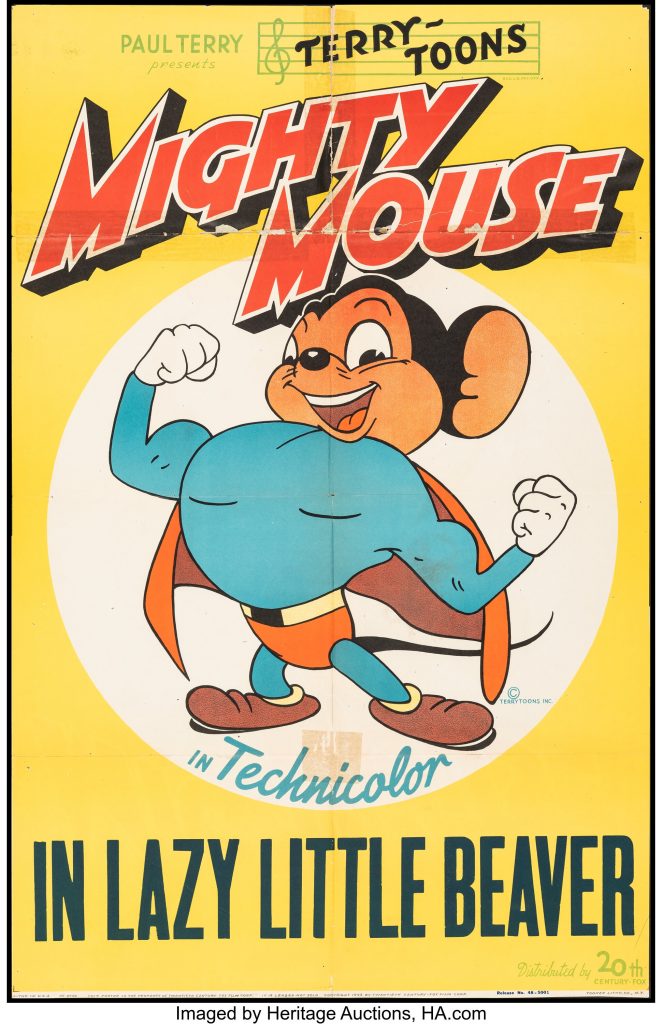
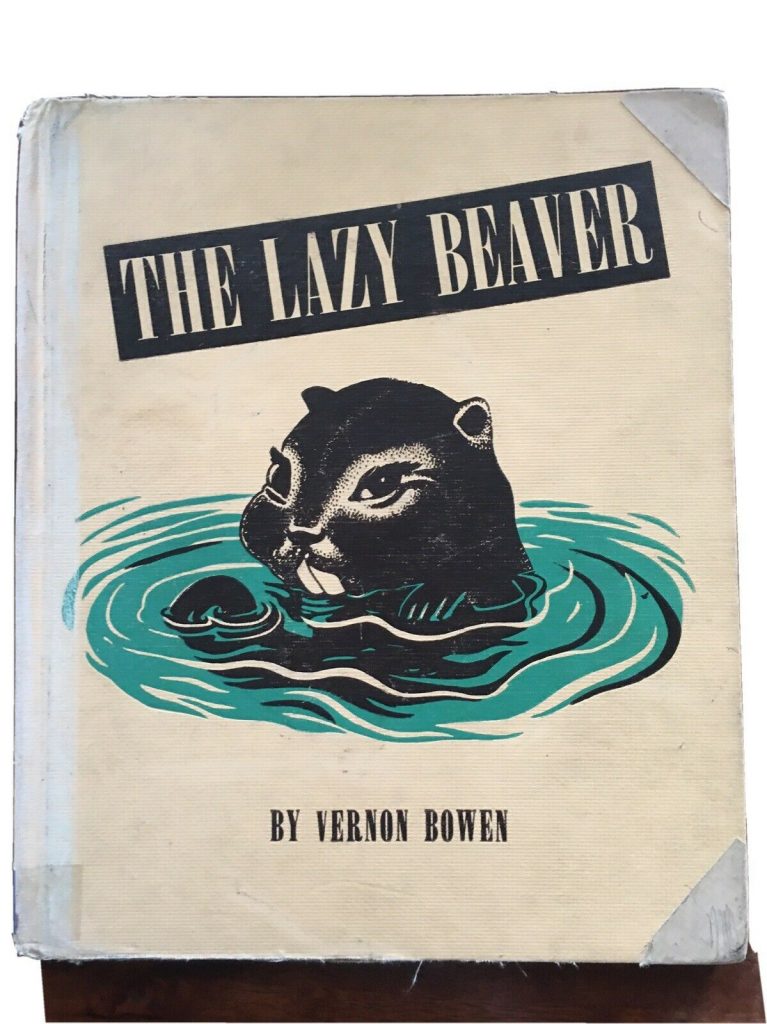
THE LAZY BEAVER: A 1948 book in which a lazy beaver… you guessed it… changes his ways. Interesting to see the contemporaneous Kirkus review, which expresses impatience with the usual moralistic beaver fable:
A beaver that couldn’t conform to the busy beaver slogan is rather a cute character. Nonconformists always are appealing — at least to the read-alouds. But like all of us, this poor fellow gets rather beaten down on his no-work policy. His fellow beavers get after him, he comes to some grief, he rescues the colony and gets to be a regular busy beaver in the lodge after all.
The tide seems to be turning.
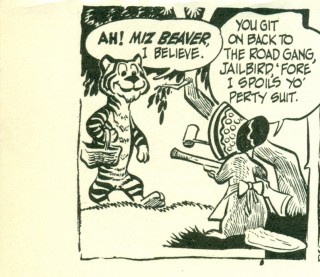
MIZ BEAVER: Walt Kelly’s comic strip Pogo debuted in 1948. I believe that the character Miz Beaver — a corncob pipe-smoking washerwoman, who “takes nothin’ from nobody,” and disapproves of menfolk — made her first appearance c. 1950–1951.
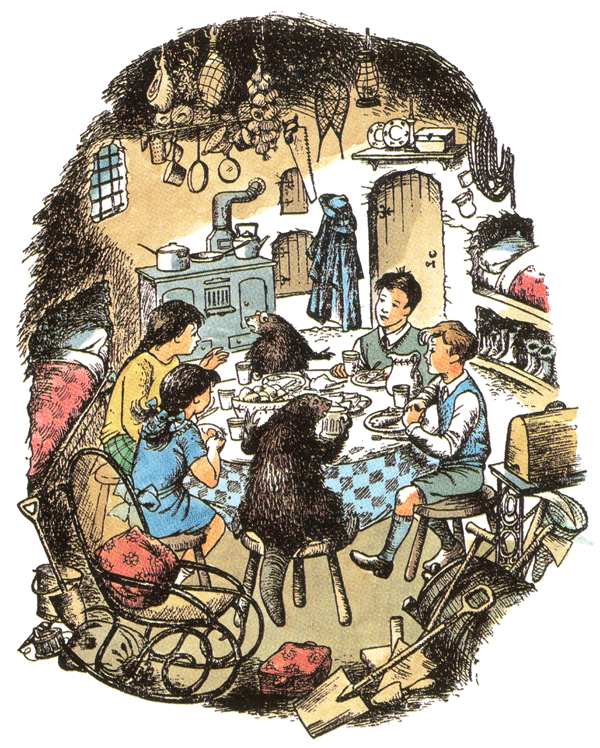
C.S. Lewis’s 1950 fantasy novel The Lion, the Witch, and the Wardrobe features a noble beaver family.
And then… we find a 1951 Terrytoons cartoon, Beaver Trouble, in which two Chip’n’Dale-like beavers work hard, in stereotypically choreographed motions… but then, anarchically, begin to steal firewood from a nearby cabin. When the home’s guard dog attempts to chase them off, they easily elude him and cause worse mischief. In the end, however, they disguise the dog as a beaver and invite him to spend the winter in their lodge. So… it’s sorta subversive, sorta sentimental. It’s a middlebrow parable.
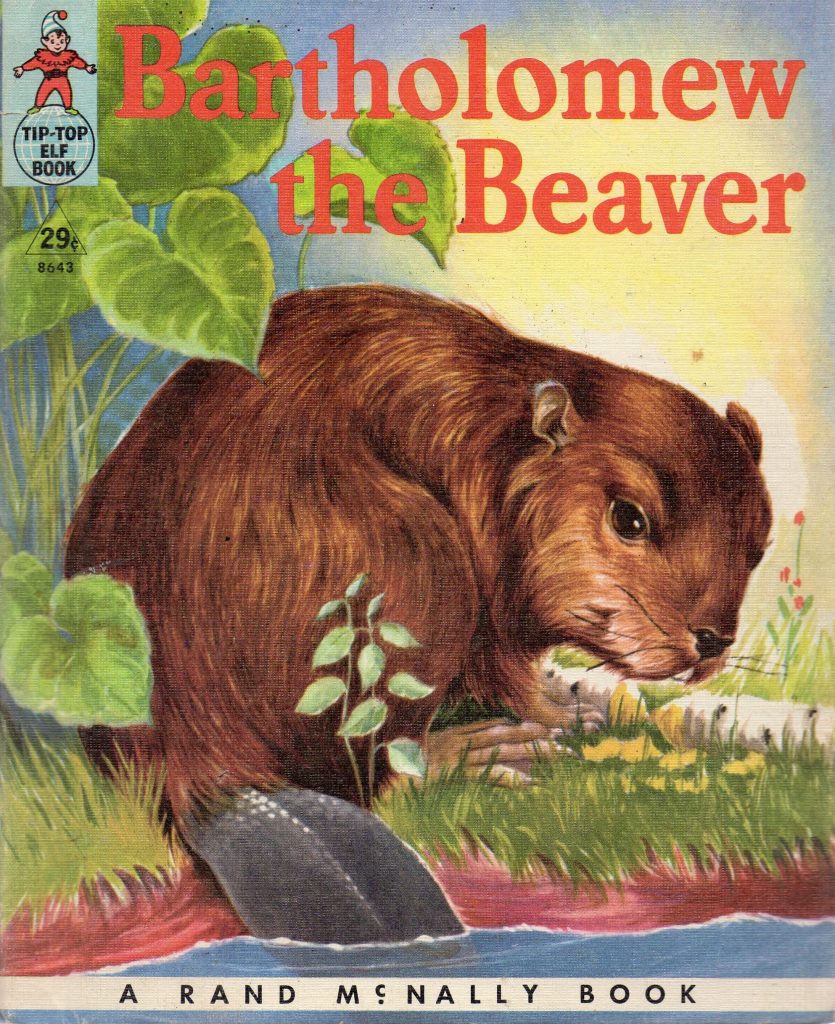
BARTHOLOMEW THE BEAVER: Bartholomew the Beaver is a 1952 children’s book in which an adorable young beaver wants to play and have fun, instead of learning to build dams, fell trees, swim underwater, and so forth. However, an encounter with a wolf teaches him a valuable lesson.

BENNY THE BEAVER: A 1953 coloring book. The cover suggests that this beaver is not particularly industrious.
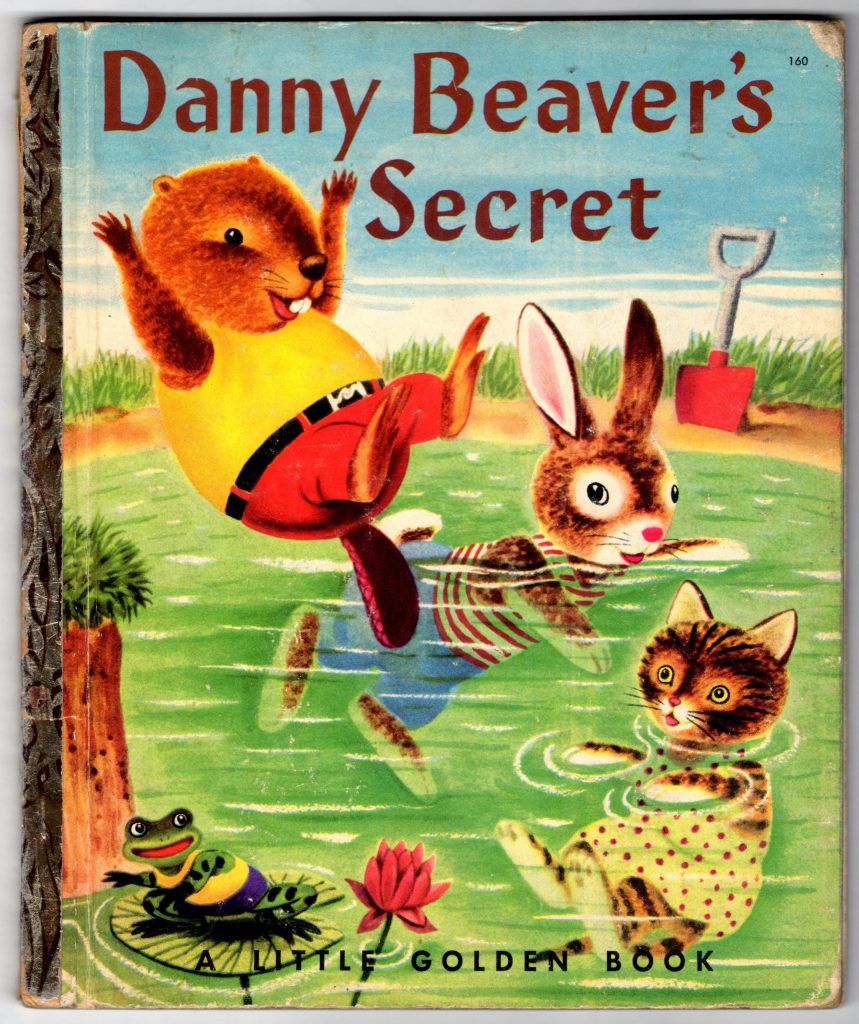
DANNY BEAVER: Another kiddie book about beavers that doesn’t seem to stress the value of industriousness.
One final entry in the Forties section:
Outside of literature and cartoons for kiddies, the beaver continued to be used as a name or logo in connection with engineering-mechanical-construction businesses. Below, for example, we find a logo for Beaver Power Tools, a line of home-shop machines introduced by a Guelph, Ontario-based company, Callander Foundry & Manufacturing Co., in the Forties.
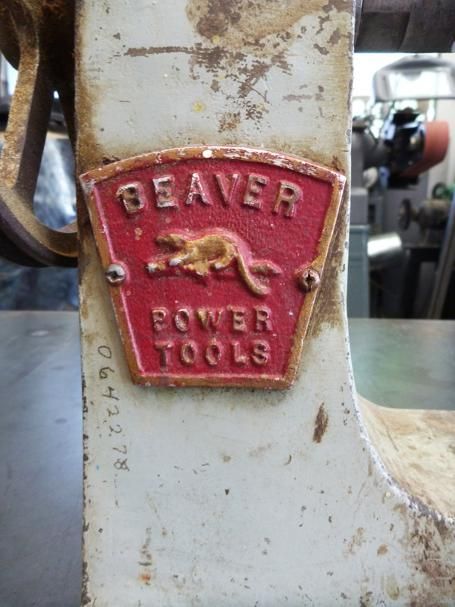
Below: A can of sewing machine oil from another Canadian company. I believe this can dates to the Forties.

Eager Beaver Trailers (see example below) was founded in 1946. The company is still going strong.
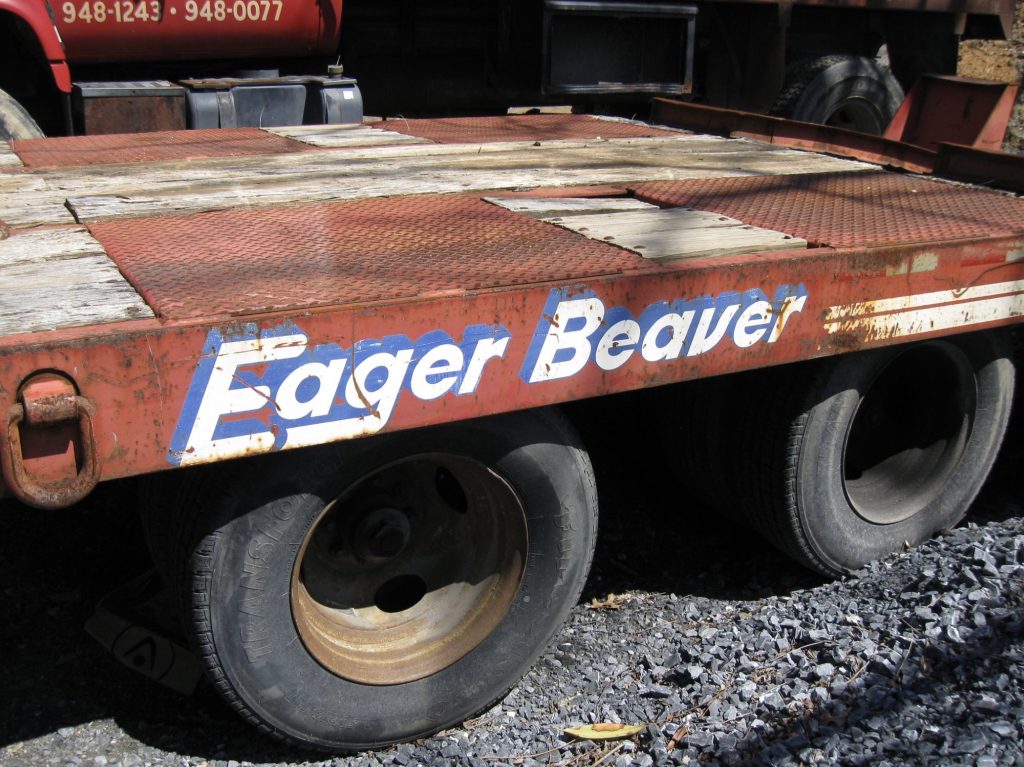
The REO Eager Beaver, shown below in a 1951 ad, was built — beginning in 1949 — as an amphibious, unstoppable truck for the US Army.
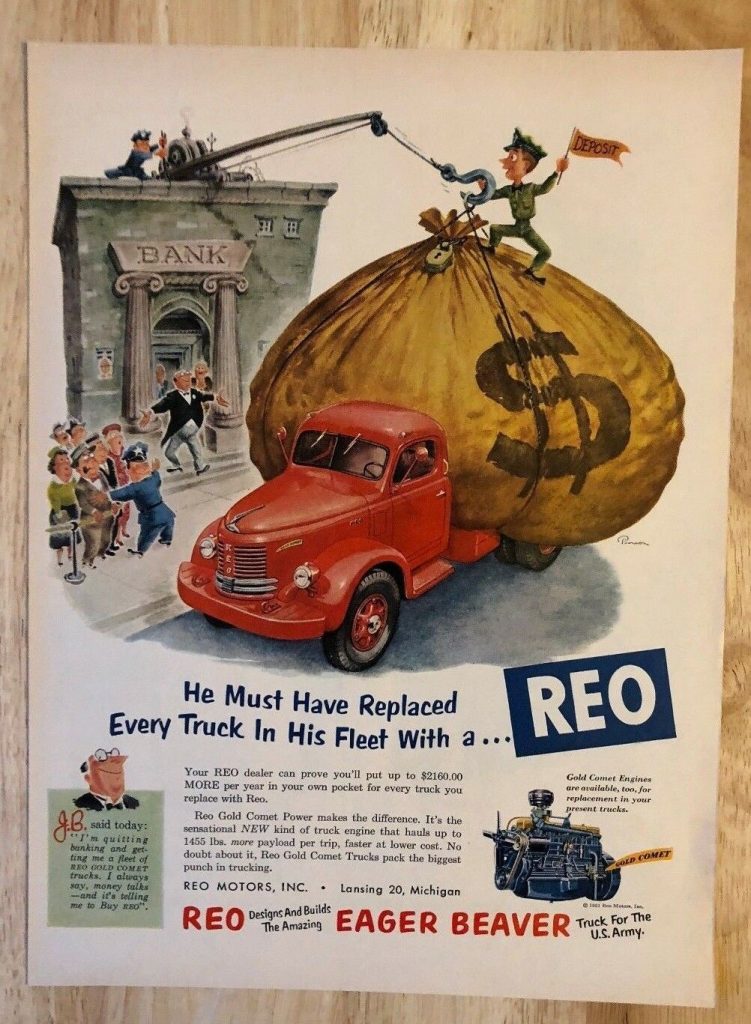
Here’s a matchbook advertising a company called Beaver Construction:
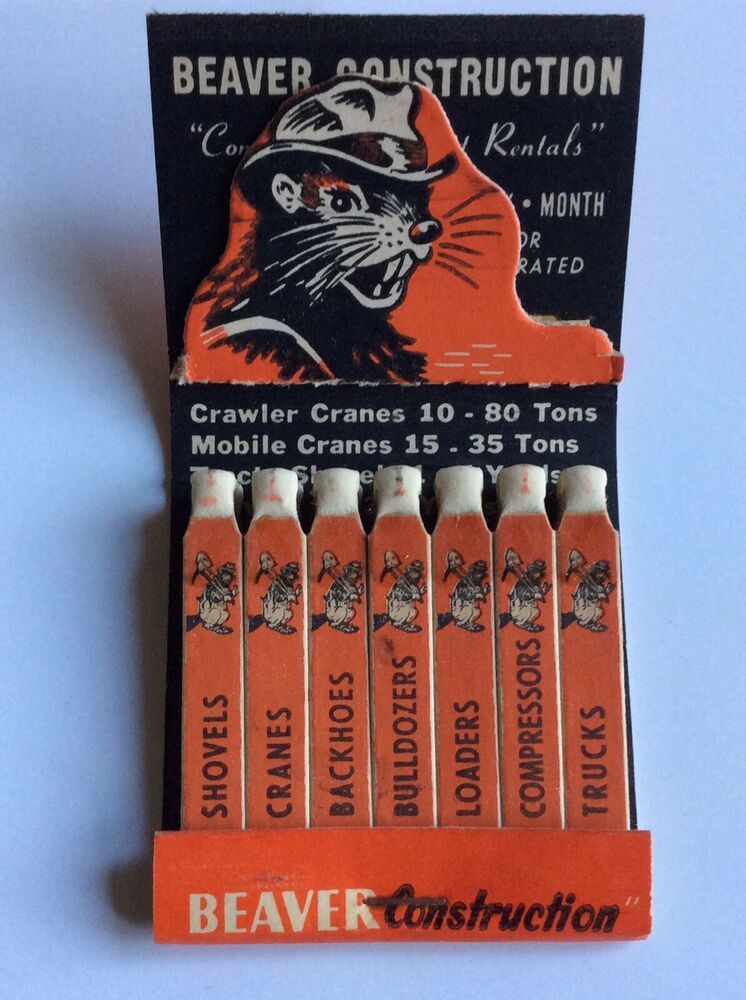
“The residual, by definition, has been effectively formed in the past, but it is still active in the cultural process, not only and often not at all as an element of the past, but as an effective element of the present,” writes Raymond Williams in the 1977 treatise Marxism and Literature. “Thus certain experiences, meanings, and values which cannot be expressed or substantially verified in terms of the dominant culture, are nevertheless lived and practised on the basis of the residue – cultural as well as social – of some previous social and cultural institution or formation.” — Raymond Williams
Beaver-centric kiddie lit seems to have lost steam by the Fifties. But as Raymond Williams notes, the past is unequally distributed — we find it continuing to shape aspects of the present. So it is that we’ll see some very old-fashioned beaver characters continue to pop up in the Fifties.
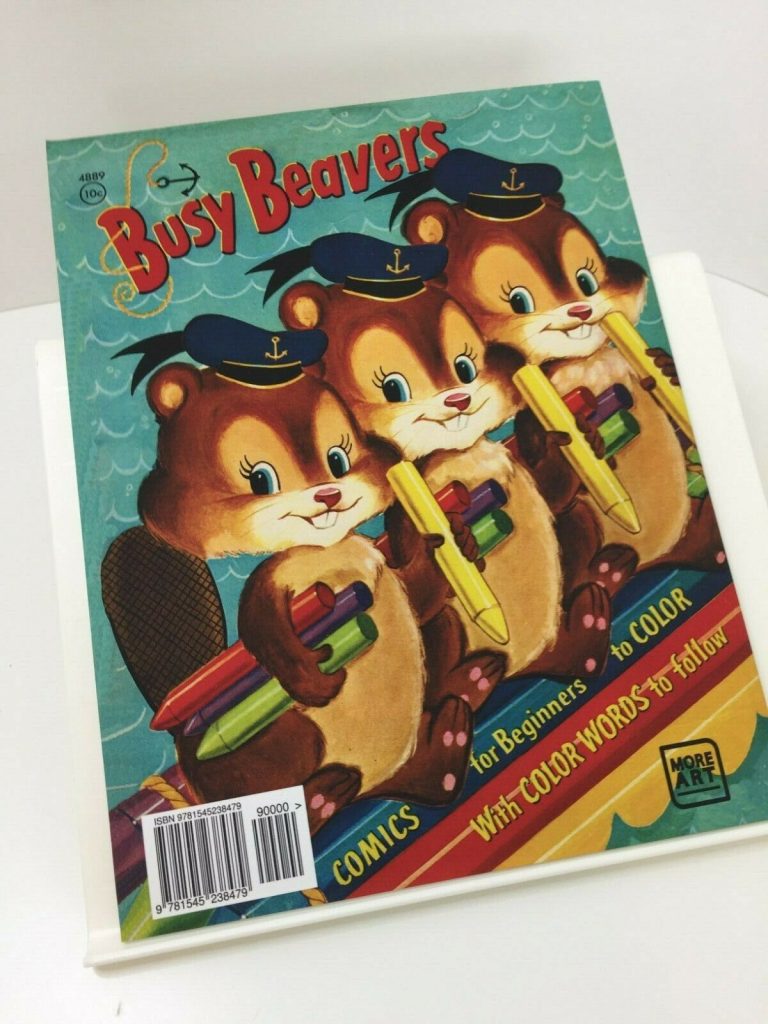
Busy Beavers coloring book, 1954.
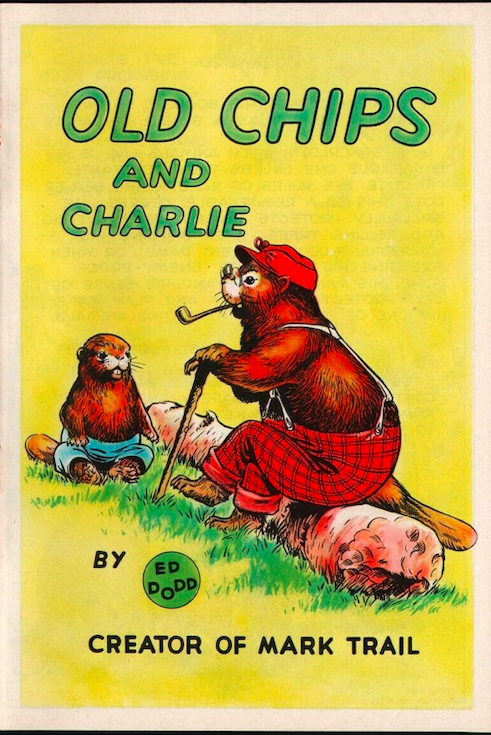
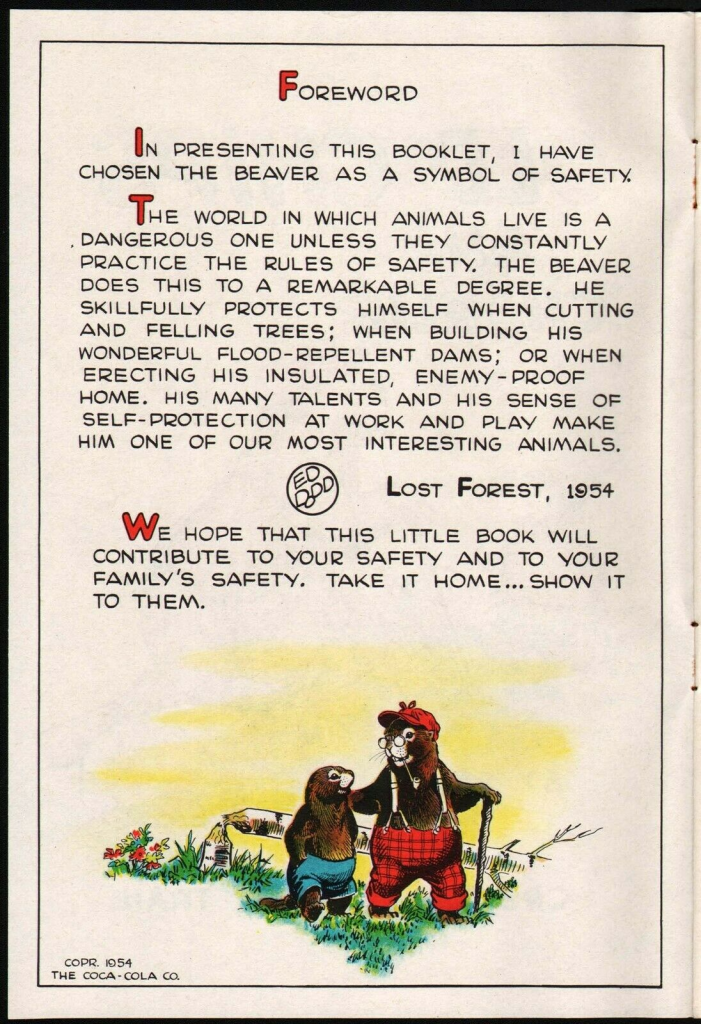
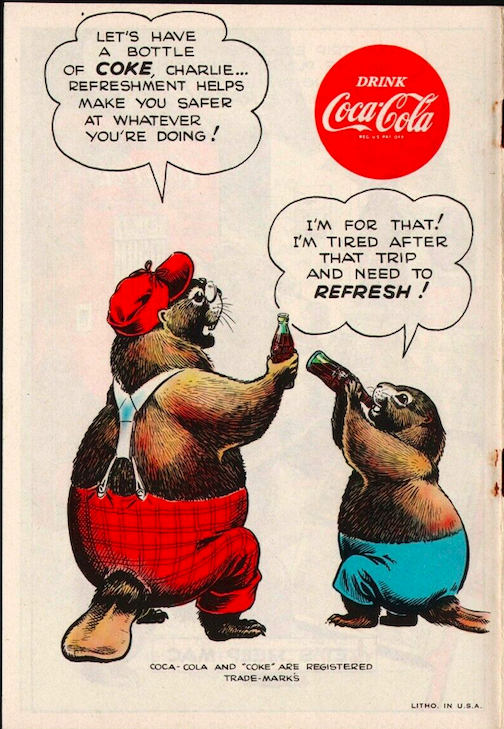
OLD CHIPS: A 1954 Coca-Cola pamphlet promoting safety to children… The beaver was selected, we read, as a symbol of safety.
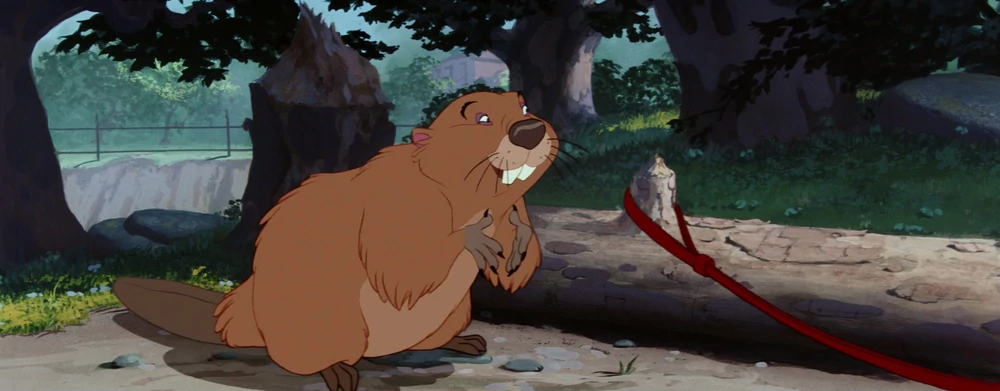
MR. BUSY: Although he looks and sounds almost identical to Gopher from the Winnie the Pooh franchise, Mr. Busy, a beaver from the 1955 animated movie Lady and the Tramp, is a classic beaver character. He’s a compulsively hard-working fellow who can’t stop dam-building long enough to have a conversation with the movie’s fugitive main characters. Tramp cons Mr. Busy into chewing off Lady’s muzzle by persuading him that it’s a useful dam-building tool: a log-puller.
Mr. Beaver is an admirable enough character, but from the viewpoint of Tramp — and the movie’s audience — he’s overly “beaverish” (to use Thomas Carlyle’s pejorative; see the first installment), i.e., he’s too focused on the task on hand, he lacks perspective.
BUCKY BEAVER: Bucky Beaver, the mascot for Ipana toothpaste, was created by Disney Commercial Studios (specifically, Disney animator David Hilberman) c. 1955 for the Bristol-Myers Company. The character, who did battle with the villainous DK Germ, was voiced by Mouseketeer Jimmie Dodd. It was Dodd who composed Bucky’s “Brusha, brusha, brusha” jingle, sometimes described as one of the catchiest jingles of all time.
Bucky’s jingle is mocked in the 1978 movie Grease (see below).
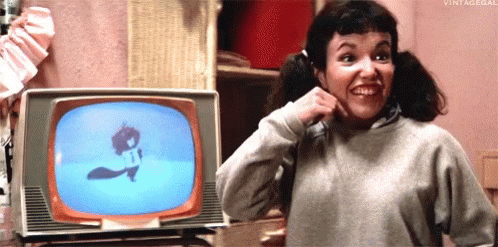
Is Bucky another cute, generic rodentoid, or is there something beaverish about him? I suppose his neurotic, compulsive jingle “Brusha, brusha, brusha” could be seen as beaverish…

Mickey Mouse dealing with cute, generic rodentoids in 1956.
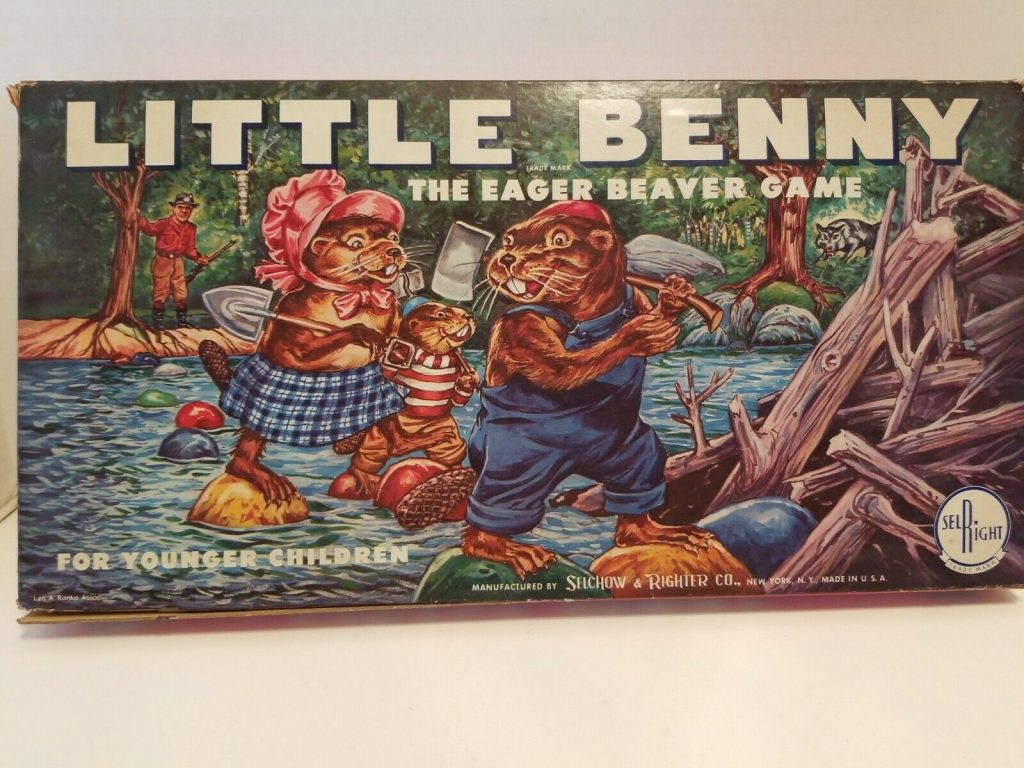
LITTLE BENNY: A 1957 children’s boardgame in which Little Benny and members of his large family maneuver from rock to rock on the way home to their lodge… while avoiding perils, from wolves to human hunters.
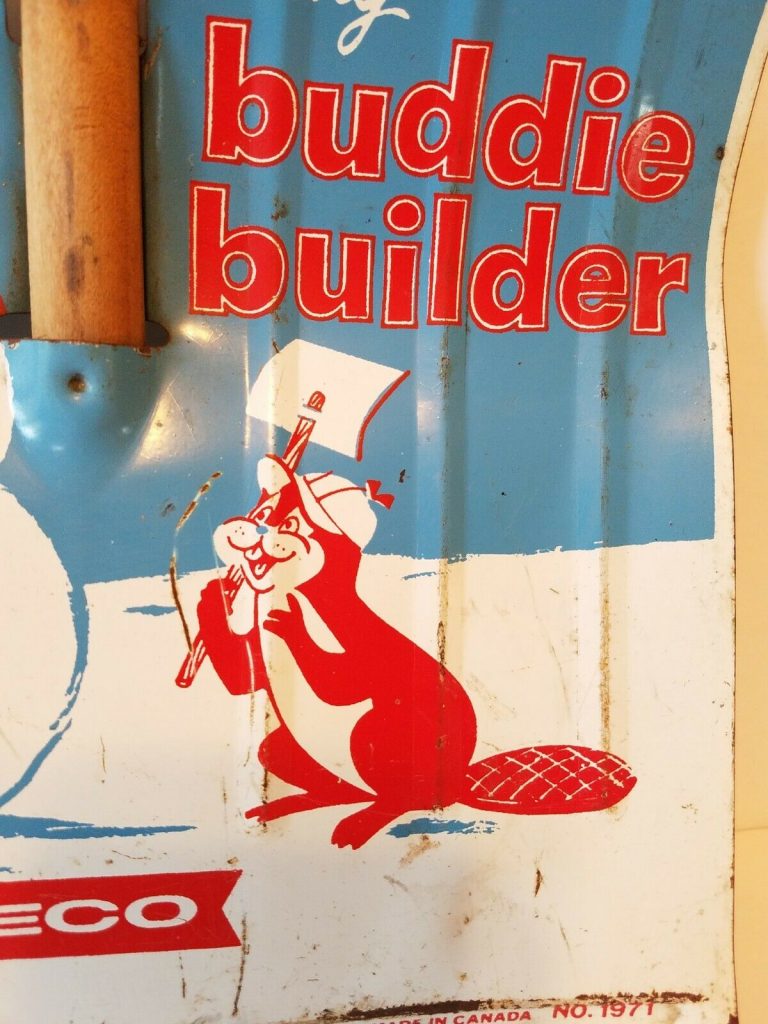
Here’s a Canadian-built children’s snow shovel from the American toy company Coleco. A cap-wearing beaver — nature’s “builder” — helps to construct a snowman.
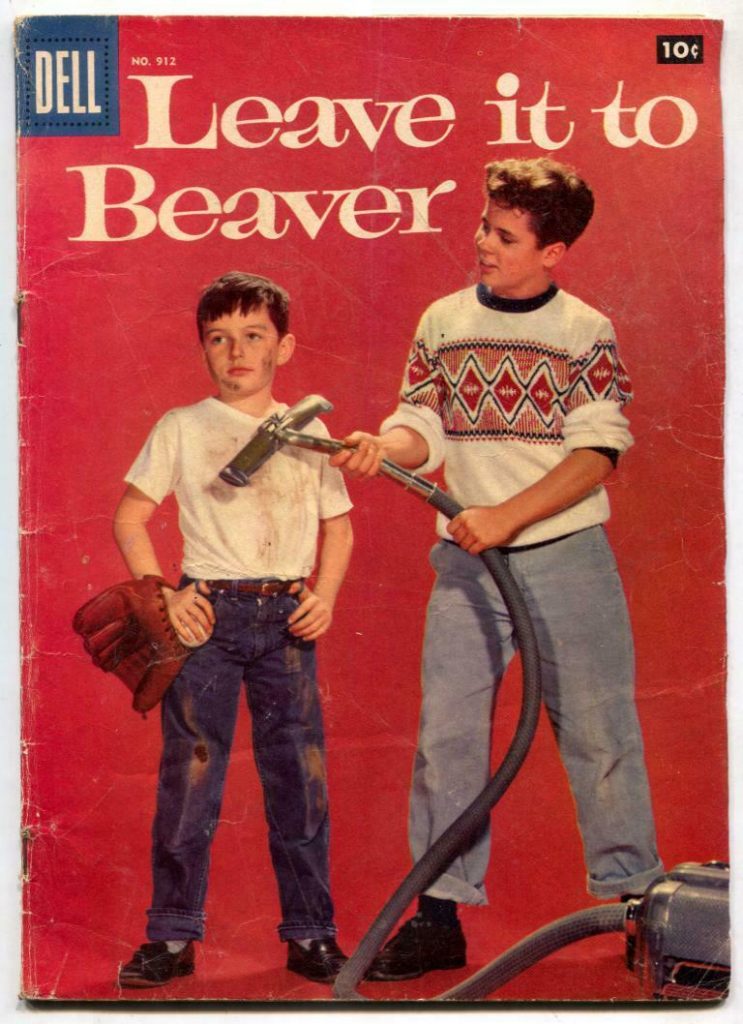
BEAVER CLEAVER: Our research from 1957 through 1963 is hampered by the popularity of the US TV sitcom Leave It to Beaver, which during those years exemplified the idealized suburban family. It was one of the first primetime sitcom series written from a child’s point of view; in this case: Theodore “The Beaver” Cleaver (Jerry Mathers), whose nickname — we learn in the series finale — was bestowed on him by his older brother, Wally, who as a tot wasn’t able to pronounce “Theodore.”
PS: As a teenager, Jerry Mathers formed a rock band called Beaver and the Trappers.
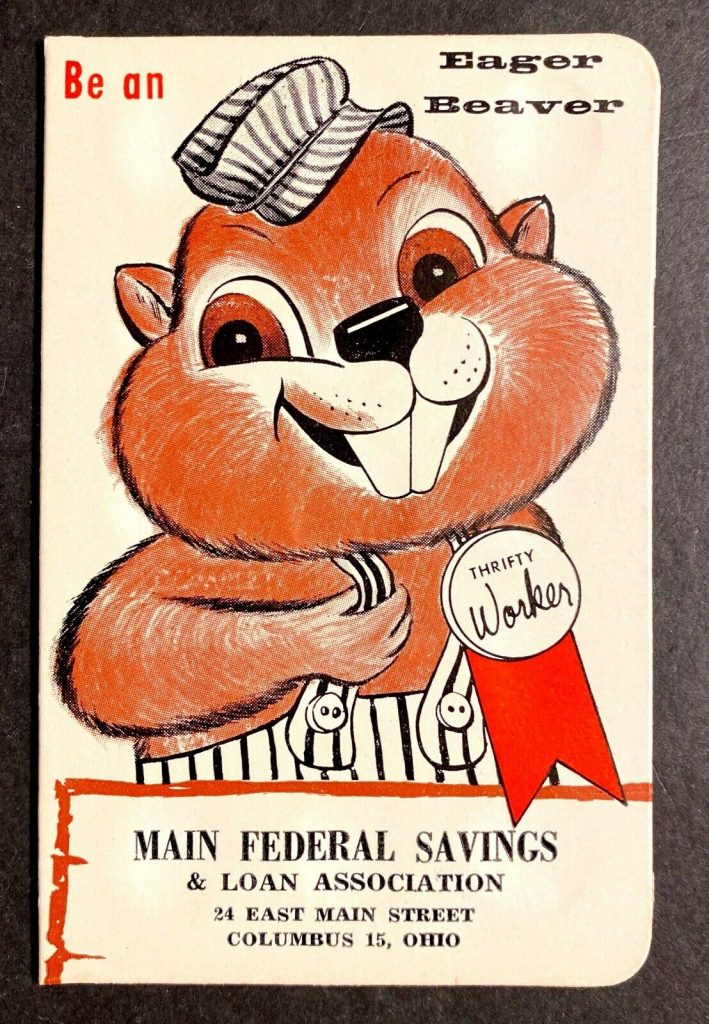
A booklet in which to save one’s dimes. For the “thrifty worker.” Below: A button that appears to be of about the same vintage.
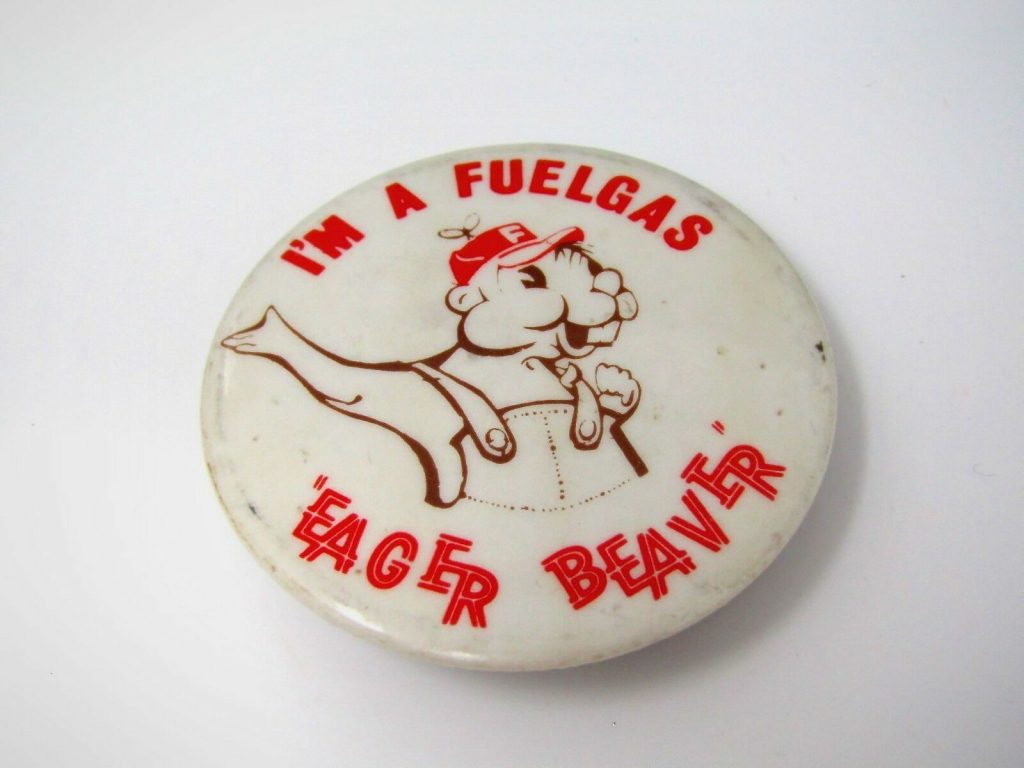

GOODMAN BEAVER: Goodman Beaver, a satirical character created in 1959 by Harvey Kurtzman (and most often drawn by Will Elder), is a naive, Candide-like character oblivious to the corruption and degeneration around him. The best-remembered Goodman Beaver stories were created in 1961–1962 for the Kurtzman-edited magazine Help!, a grownup version of MAD. After Kurtzman and Elder parodied Hugh Hefner in a 1962 Goodman Beaver strip, Hef hired them to create a sexpot female version of the Goodman Beaver character, Little Annie Fanny, for Playboy.
Why “Beaver”? By this point, the vulgar slang meaning of the word was apparently inescapable. Everyone got the joke. I suspect this is why we begin to see a rapid decline in pop-culture beavers.
EAGER BEAVER: Even as Kurtzman and Elder signal that the very word “beaver” is hilarious and vulgar, in the very same year of 1959 Cities Service Oil Co. (later: Citgo) began distributing promotional comics and activity books about Eager Beaver and his road-tripping family.
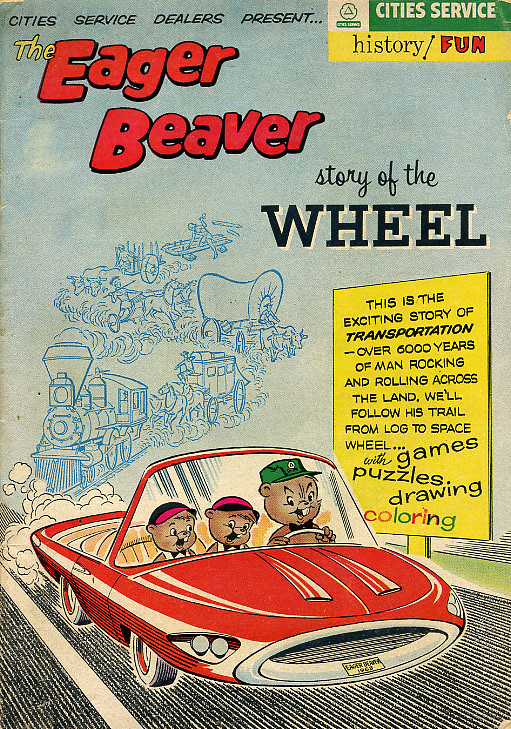
These publications appeared from 1959 through c. 1964.
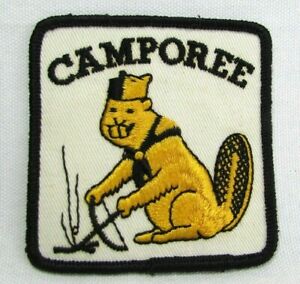
1960 Boy Scout’s patch.
On “Beaver Or Not,” a 1961 Popeye cartoon directed by Gene Deitch, Popeye’s camping trip in the wild north woods is disrupted by mischievous beavers — cute rodentoids — who build a dam that spoils Popeye’s swimming. In the end, the rodentoids triumph.
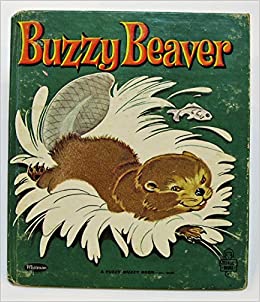
BUZZY BEAVER: Buzzy Beaver is a 1961 Whitman Tell A Tale Fuzzy Wuzzy Book that’s every bit as cliched and saccharine as those words sound. Father and Mother Beaver despair of Buzzy, who doesn’t want to help build a dam or lodge, or learn beaver ways. (His cousin Eager does, though; one is reminded of the dynamic between Ash and Kristofferson in the 2009 Wes Anderson adaptation of Roald Dahl’s Fantastic Mr. Fox.) As in just about every kiddie book since the beginning of the 20th century, though, an encounter with a predator teaches Buzzy to shape up.
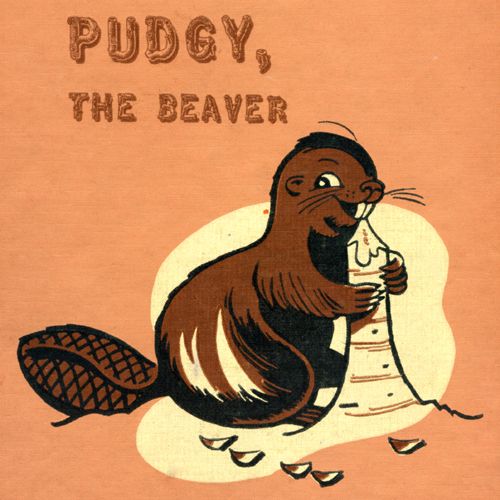
Pudgy, the Beaver — a 1963 kiddie book I haven’t read.
Coming next: BEAVER 1964–2003
INTRODUCTION by Matthew Battles: Animals come to us “as messengers and promises.” Of what? | Matthew Battles on RHINO: Today’s map of the rhinoceros is broken. | Josh Glenn on OWL: Why are we overawed by the owl? | Stephanie Burt on SEA ANEMONE: Unable to settle down more than once. | James Hannaham on CINDER WORM: They’re prey; that puts them on our side. | Matthew Battles on PENGUIN: They come from over the horizon. | Mandy Keifetz on FLEA: Nobler than highest of angels. | Adrienne Crew on GOAT: Is it any wonder that they’re G.O.A.T. ? | Lucy Sante on CAPYBARA: Let us gather under their banner. | Annie Nocenti on CROW: Mostly, they give me the side-eye. | Alix Lambert on ANIMAL: Spirit animal of a generation. | Jessamyn West on HYRAX: The original shoegaze mammal. | Josh Glenn on BEAVER: Busy as a beaver ~ Eager beaver ~ Beaver patrol. | Adam McGovern on FIREFLY: I would know it was my birthday / when…. | Heather Kapplow on SHREW: You cannot tame us. | Chris Spurgeon on ALBATROSS: No such thing as a lesser one. | Charlie Mitchell on JACKALOPE: This is no coney. | Vanessa Berry on PLATYPUS: Leathery bills leading the plunge. | Tom Nealon on PANDA: An icon’s inner carnivore reawakens. | Josh Glenn on FROG: Bumptious ~ Rapscallion ~ Free spirit ~ Palimpsest. | Josh Glenn on MOUSE.
